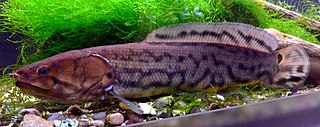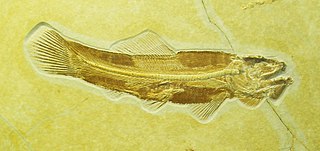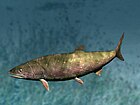
Actinopterygii, members of which are known as ray-finned fish or actinopterygians, is a class of bony fish that comprise over 50% of living vertebrate species. They are so called because of their lightly built fins made of webbings of skin supported by radially extended thin bony spines called lepidotrichia, as opposed to the bulkier, fleshy lobed fins of the sister class Sarcopterygii. Resembling folding fans, the actinopterygian fins can easily change shape and wetted area, providing superior thrust-to-weight ratios per movement compared to sarcopterygian and chondrichthyian fins. The fin rays attach directly to the proximal or basal skeletal elements, the radials, which represent the articulation between these fins and the internal skeleton.

The bowfin is a bony fish, native to North America. Common names include mudfish, mud pike, dogfish, grindle, grinnel, swamp trout, and choupique. It is regarded as a relict, being one of only two surviving species of the Halecomorphi, a group of fish that first appeared during the Early Triassic, around 250 million years ago. The bowfin is often considered a "primitive fish" because they have retained some morphological characteristics of their early ancestors. It is one of two species in the genus Amia, along with Amia ocellicauda, the eyespot bowfin. The closest living relatives of bowfins are gars, with the two groups being united in the clade Holostei.

The Amiiformes order of fish has only two extant species, the bowfins: Amia calva and Amia ocellicauda, the latter recognized as a separate species in 2022. These Amiiformes are found in the freshwater systems of North America, in the United States and parts of southern Canada. They live in freshwater streams, rivers, and swamps. The order first appeared in the Triassic, and the extinct members include both marine and freshwater species, many of which are morphologically disparate from bowfins, such as the caturids.

The Amiidae are a family of basal ray-finned fishes. The bowfin and the eyespot bowfin are the only two species to survive today, although additional species in all four subfamilies of Amiidae are known from Jurassic, Cretaceous, and Eocene fossils.

Holostei is a group of ray-finned bony fish. It is divided into two major clades, the Halecomorphi, represented by the single living genus, Amia with two species, the bowfins, as well as the Ginglymodi, the sole living representatives being the gars (Lepisosteidae), represented by seven living species in two genera. The earliest members of the clade, which are putative "semionotiforms" such as Acentrophorus and Archaeolepidotus, are known from the Middle to Late Permian and are among the earliest known neopterygians.

The Fort Union Formation is a geologic unit containing sandstones, shales, and coal beds in Wyoming, Montana, and parts of adjacent states. In the Powder River Basin, it contains important economic deposits of coal, uranium, and coalbed methane.
The Paleocene, or Palaeocene, is a geological epoch that lasted from about 66 to 56 million years ago (mya). It is the first epoch of the Paleogene Period in the modern Cenozoic Era. The name is a combination of the Ancient Greek παλαιός palaiós meaning "old" and the Eocene Epoch, translating to "the old part of the Eocene".
Siamamia is an extinct genus of ray-finned fish from Northeasthern Thailand. They belong to family Amiidae and are halecomorph fishes endemic to Early Cretaceous freshwater environments in eastern Asia.

Calamopleurus is an prehistoric genus of marine holostean ray-finned fish from the Early Cretaceous of South America and northern Africa. It was a relative of the modern bowfin, with both belonging to the family Amiidae.

Halecostomi is the name of a group of neopterygian fish uniting the halecomorphs and the teleosts, the largest group of extant ray-finned fish.
Ampheristus is an extinct genus of prehistoric marine ray-finned fish. It was a basal or stem member of the family Ophidiidae, which contains modern cusk-eels. Fossils are known from worldwide from the Late Cretaceous to the late Paleogene, making it a rather successful survivor of the Cretaceous-Paleogene extinction event.
The Ravenscrag Formation is a stratigraphic unit of early Paleocene age in the Western Canada Sedimentary Basin. It was named for the settlement of Ravenscrag, Saskatchewan, and was first described from outcrops at Ravenscrag Butte near the Frenchman River by N.B. Davis in 1918.

Halecomorphi is a taxon of ray-finned bony fish in the clade Neopterygii. The only extant Halecomorph species are the bowfin and eyespot bowfin, but the group contains many extinct species in several families in the order Amiiformes, as well as the extinct orders Ionoscopiformes, Panxianichthyiformes, and Parasemionotiformes. The fossil record of halecomorphs goes back at least to the Early Triassic epoch.
Melvius is a genus of vidalamiin amiid fish from the Late Cretaceous. The type species, Melvius thomasi, was described by Bryant in 1987 from Hell Creek Formation. A second species Melvius chauliodous, was named and described by Hall and Wolburg in 1989 from Kirtland Formation, and it is now considered to be one of the index taxa of the Kirtlandian land-vertebrate age. Both species of Melvius were very large at its size. A vertebral remain of M. thomasi would belongs to fish with standard length of 161 cm (5.28 ft), and there are some specimens exceeds height of that vertebra. Total length of this species would be at least 193–205 cm (6.33–6.73 ft). However, M. thomasi would be a “dwarf” compared to M. chauliodous, a specimen of M. chauliodous with abdominal centra which is 6.57 cm (2.59 in) wide would indicate standard length over 2 m (6.6 ft), and there is even larger abdominal centra which is 7.3 cm (2.9 in) wide.

Roger Lansing Grande, more commonly known as Lance Grande, is an evolutionary biologist and curatorial scientist. His research and work is focused on Paleontology, Ichthyology, Systematics and Evolution. He is well known for his work on the paleontology of the Green River Formation and for his detailed monographs on the comparative anatomy and evolution of ray-finned fishes. He has also published books on broader issues, engaging larger audiences on the importance of the natural and the social sciences.

Amia? hesperia is an extinct species of bony fish in the bowfin family, Amiidae. The species is known from fossils found in the early Eocene deposits of northern Washington state in the United States and southeastern British Columbia. The species is one of eight fish species identified in the Eocene Okanagan Highlands paleofauna.
Maliamia is an extinct genus of amiid ray-finned fish from the Early Eocene, known from fragmentary remains found in the Tamaguélelt Formation of Mali. It was described in 1989, based on fossils recovered by three separate expeditions in 1975, 1979–80, and 1981. The type species is Maliamia gigas, named in reference to its large size.

Amia ocellicauda, the eyespot bowfin, is a species of bowfin native to North America. Originally described by John Richardson from Lake Huron in 1836, it was synonymized with Amia calva until genetic work in 2022 revealed them to be separate species. This species ranges from around the Great Lakes south to the Gulf Coast wetlands of Louisiana and Texas. It is absent from the southeast, where its sister species Amia calva is found instead.
This list of fossil fish research presented in 2024 is a list of new taxa of jawless vertebrates, placoderms, acanthodians, fossil cartilaginous fishes, bony fishes, and other fishes that were described during the year, as well as other significant discoveries and events related to paleoichthyology that occurred in 2024.
Amia basiloides is an extinct species of giant bowfin that inhabited western North America during the Middle or Late Paleocene, about 5-10 million years after the Cretaceous-Paleogene extinction event. The species name originates from the Ancient Greek βασιλεύς (basileus), meaning "king", referencing its immense size.














